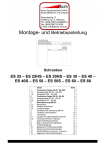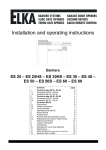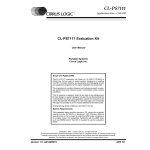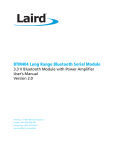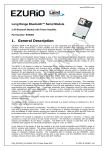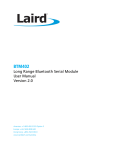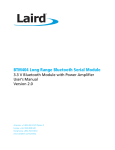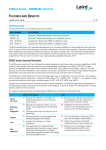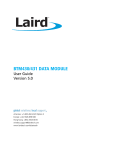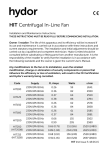Download ACC-006 User Manual
Transcript
Bluetooth Audio Development Pack OKI 7702 Codec Board User Guide Part Number ACC-006 The information contained in this document is subject to change without notice. EZURiO Ltd makes no warranty of any kind with regard to this material including, but not limited to, the implied warranties of merchant ability and fitness for a particular purpose. EZURiO Ltd shall not be liable for errors contained herein or for incidental or consequential damages in connection with the furnishing, performance, or use of this material. © Copyright 2007 EZURiO Limited. All rights reserved. No part of this document may be photocopied, reproduced, or translated to another language without the prior written consent of EZURiO. Bluetooth is a trademark owned by Bluetooth SIG, Inc., USA and licensed to EZURIO Ltd. Other product or company names used in this publication are for identification purposes only and may be trademarks of their respective owners. APN_06003_1v0 OKI Audio Board.DOC 1 Bluetooth® Development Kit OKI Audio Codec Board Part Number: ACC-006 1. General Description The EZURiO OKI Codec Evaluation Board plugs into the EZURiO Developers kit and allows you to rapidly test and evaluate Bluetooth audio applications using the EZURiO Bluetooth Intelligent Serial Module to implement the wireless link. The ACC-006 evaluation board is based on the OKI 7702 codec - a 3.3V, single channel codec that supports A-law and μ-law coding. The codec is used to digitise incoming audio from the microphone into PCM data and convert the PCM digital audio output of the Bluetooth chip into an analogue signal for the headphones. The codec board has a microphone input and headphone output which are compatible with standard PC headsets. The 7702 codec has several features such as power down mode. The ACC-006 codec evaluation board provides options to allow these features to be tested. This document provides you with information to prototype and evaluate your own audio application. Once you have tried out your application, you will be able to design your own audio solution based around the OKI codec and the EZURiO Bluetooth Intelligent Serial module. APN_06003_1v0 OKI Audio Board.DOC 2 2. Overview The codec board is powered by an on-board 3.3V regulator to reduce noise to a minimum. The PCM control signals for the codec go directly to the Bluetooth module on the motherboard via the 10-way connector, as do the 3 push button switches. This allows the switches to be used with an external program that implements the upper portion of headset or Handsfree profile. The microphone input, designed to interface to PC compatible headsets, has a fixed gain of 10 set by external components to the codec (the amplifier itself is part of the codec). Part of the microphone signal is mixed into the headphone output signal via VR1. This feature is known as “sidetone” and allows the user to hear their own voice when speaking. It is commonly used in telephony applications to give the user the necessary audio feedback that their ears expect. The audio output gain is by default fixed at 2.5. By fitting VR2, the audio gain can be made adjustable. The 120mW stereo output amplifier U3 ensures that the codec board can drive standard 32Ω stereo headphones while keeping total harmonic distortion down to 0.1%. 3. Component Placement Note that not all components are fitted – non-fitted components are shown without pads. Refer to Section 7 for details of component fitment and specification. APN_06003_1v0 OKI Audio Board.DOC 3 3. Codec Board Quick Start Guide 3.1 Getting Started The codec board is supplied with a right angle, 10 way connector that can be used to connect it to the main developers kit. If required, this should be soldered to the main board. Alternatively other connectors or ribbon cables can be used. 3.2 • • • Equipment Required (not supplied) Headsets (with microphone) (Standard PC headsets are fine) EZURiO Wireless Developers Kit BISM II Bluetooth module Normally two sets of development kit are required to test both ends of an audio link. If an application is being developed with an existing endpoint, such as a mobile phone or headset, only one set may be needed. 3.3 Motherboard Jumper Settings Before using the codec board, there is a jumper setting on the motherboard that needs to be checked. This is CB1, next to the USB adaptor, which must be removed. If fitted it will short out the PCM output from the codec and prevent it operating. CB1 is only relevant for the WLAN 802.11 data module. REMOVE 3.4 Procedure: 1) Check that SW1 on the codec board is correctly set to the default position (see section 6.3 of this manual). 2) Plug the BISM II into the socket on the Dev Kit, connect to a PC serial port and power up. See the dev kit manual for different power supply options. 3) Check that AT commands are working using EZURiO terminal. (Refer to blu2i Quick Start Guide if needed) 4) Power down, plug the codec board into the dev kit and power up. Check that AT commands are working. APN_06003_1v0 OKI Audio Board.DOC 4 Configure the Slave unit as follows: AT&F* ATZ ATS103=3 ATS512=4 ATS0=1 ATS531=1 AT&W ATZ Restore system defaults Reset the unit Set boot mode to OKI Codec A Law Make connectable and discoverable Answer after 1 ring Keep AT command mode going after a connection is established Save the above settings Reset the unit. 5) Find out the Bluetooth address of the Slave Unit by typing ATI4<return> 6) Configure the Master Unit as follows: AT&F* ATZ ATS103=3 ATS531=1 AT&W ATZ ATD008098nnnnnn AT+BTA1 Restore System Defaults Reset the unit Set boot mode to OKI Codec Keep the AT commands going after a connection is established Save to flash Reset the unit. Connect to the slave (substitute your slave’s Bluetooth address that you found in step 5 for nnnnnn) Establish an audio link – displays AUDIO ON on both sides. (Alternatively AT+BTA7 can be used and the units will negotiate the best link type.) An Audio link is now established between the two units. AT=BTA0 will turn off the audio link (but still leave the units connected). Note the command ATS103=3. This configures the PCM parameters to support the 8 bit, A-law coding for the OKI 7702. The default for the BISM module is to support a linear 13 bit codec. Unless this command is issued and stored on each module, then the OKI codec will not work. 4. Bluetooth SCO Links – A Primer 4.1 Normal SCO Bluetooth uses a Synchronous Connection-Orientated link (SCO) for audio. All this means is that for an audio link, the bandwidth needed to maintain the data rates required by the audio link is pre-allocated between the master and slave. This ensures audio data is always transmitted at the required data rate, and takes priority over the transmission of digital data. The Bluetooth specification for SCO is such that there is no re-transmission if data is corrupted or lost. This explains the crackling and popping that occurs when you get to the limits of radio range. The actual data rate over the air is 64 kbits/sec. There are 1600 timeslots available per second and when a master transmits a SCO packet in one timeslot, the slave replies with its SCO packet in the next. The SCO packet size is fixed at 240 bits (30 bytes). This means when a SCO link is established using the HV3 packet type, two out of every 6 timeslots are used up by the SCO link. This means there is enough bandwidth to have up to three SCO links active between a master and slave at the same time. In this scenario, there are no spare timeslots for other data. APN_06003_1v0 OKI Audio Board.DOC 5 There are 3 main types of SCO packets, HV1, HV2 and HV3 (High Quality Voice). As mentioned earlier, the HV3 packet type has a 1 to 1 mapping between incoming audio data and the data transmitted over the air. There is no error correction possible with HV3. With HV1, each bit is transmitted 3 times and a simple voting algorithm is used at the other end to correct for any bit errors. This means that only 10 bytes of actual audio data can be transmitted in a SCO packet. To maintain the 64 kbits/sec data rate, all 6 timeslots have to be used for the SCO link, leaving no bandwidth available for data. With HV2, an FEC algorithm is used to correct for 1 bit errors. This increases the data packet size by 50%. This means that only 20 bytes of actual audio data can be transmitted in a SCO packet. To maintain the 64 kbits/sec data rate, 4 out of every 6 timeslots are used for the SCO link. AT+BTA1 enables HV3 AT+BTA2 enables HV2 AT+BTA4 enables HV1 AT+BTA7 allows the link manager to negotiate which packet type to use, the default is HV1 4.2 Enhanced SCO Enhanced SCO or eSCO was implemented as part of the 1.2 Bluetooth Core Specification Release. The main driving factor was to improve audio quality. This has been achieved by: 1) including a CRC as part of the audio data packet to allow error detection and a retransmission request. 2) allowing higher data rates by using packets that span more than 1 timeslot 3) allowing asymmetric links to allow high quality audio to be streamed in one direction. eSCO offers significantly better audio quality, but has to be configured at both ends of the link before a unit is enabled to accept incoming connections or enquiries. To try out eSCO, add the ATS584=1 command to the commands listed in the quick start section immediately after the AT&F* and ATZ commands. Both ends of the link must be configured for eSCO for the audio link to be established. If one end is set to eSCO and the other to SCO, you will get an “AUDIO FAIL” when the AT+BTA1 command is issued. The following are the packet types associated with the AT+BTA commands for eSCO. AT+BTA1 – EV3 packet. Up to 30 bytes + CRC. Uses up 1 timeslot AT+BTA2 – EV4 packet. Up to 120 bytes + CRC + 2/3 FEC. Up to 3 timeslots AT+BTA4 – EV5 packet. Up to 180 bytes + CRC. Up to 3 timeslots. Currently Unsupported 4.3 SCO / eSCO Transport Delays The following delays have been measured between incoming audio and audio output at the other end of a Bluetooth link. Normal SCO: AT+BTA1 AT+BTA2 AT+BTA4 7.84 ms 9.24 ms 10.8 ms Enhanced SCO AT+BTA1 AT+BTA2 AT+BTA4 12.1 ms 33.4 ms 41.2 ms APN_06003_1v0 OKI Audio Board.DOC 6 As can be seen, the additional error correction of eSCO comes with a transport delay penalty. This is because a buffer is needed to ensure that there is still data to output while waiting for a corrupted data packet to be re-transmitted. For AT+BTA1 and normal SCO, the data is transmitted once every 6 timeslots so the transport delay is expected to be 6/1600 = 3.75ms. When doing loop-round testing with the codec, i.e. with no transport delay, it was found that from input to output, the codec added ~1ms of delay at 1kHz and 1.5ms at lower frequencies. 4.4 PCM Timing The codec samples at 8 kHz. The default mode of operation of the codec is 8 bit A Law encoding. In this mode, in every 8 kHz cycle, 8 bits of data is clocked into the codec. The clock rate used for sampling is 250kHz (4µs). 8 clock cycles takes 32µs. 8kHz equates to 125µs. The same timing is used for all packet types in both SCO and eSCO modes. 5. Frequency Response 5.1 Codec Frequency Response The codec frequency response can be measured by connecting PCM_IN from the codec to PCM_OUT to the codec (PCM_OUT from J1, the 10 way connector has to be disconnected). A 1kΩ pull down resistor is needed on PCM_OUT to ensure maximum volume setting. The side-tone resistor R18 should also be removed to prevent audio feedback. To perform the measurement, inject a 1V peak to peak sine wave injected into the microphone circuit. (Its amplitude can be measured at TP6, GS+, the input to the codec.) The output from the codec should be measured on TP9, AOUT. 5.2 Bluetooth Link Frequency Response The Codec 8bit data is coded within the Bluetooth chip using CVSD (Continuous Variable Slope Decode) encoding for transport over the Bluetooth link. CVSD is essentially a form of Adaptive Differential PCM (ADPCM) and is well suited for voice transmission. It is forgiving of individual bit corruption as each bit only implements an up or a down shift relative to the previous level (corruption of the MSB of a 8 bit sample would create a much larger error term than is possible with ADPCM). A draw back of ADPCM is that it cannot track large delta changes in signal quickly enough. For voice, this does not present a problem. The chart below shows the frequency response of the Bluetooth link at different levels of input sine wave. As can be seen, the frequency response can only be considered to be flat when the input voltage level is less than a 0.3V peak to peak sine wave. Over the Air Frequency Transfer Characteristics 1.2 1 Voltage (V) 0.8 Codec Loop Around Test 1V Sine W ave 0.6 0.6V Sine W ave 0.3V Sine W ave 0.4 0.2 0 0 1000 2000 3000 4000 Frequency (Hz) APN_06003_1v0 OKI Audio Board.DOC 7 6. Circuit Description This section describes the individual parts of the circuit and give design information about the components, to allow you to adapt the circuitry of the codec board for your own implementation. 6.1 Audio Amplifier The OKI codec is capable of driving a 1.2KΩ load directly with a max output signal of 2.0Vpp. Of the stereo headsets tested, it was found that 32Ω was a common impedance for each earpiece. For a stereo headset where two speakers are being driven in parallel this would be equivalent to driving a 16Ω load. This is out of the codec’s specification so a small headphone amplifier, U3, has been used on the evaluation board. This is not required if the codec is driving a load of 1.2KΩ or higher. The large 47 μF decoupling capacitor has been used so that the codec could be tested down to its lowest frequency of 300 Hz. If you do not require a frequency response to go down below 300 Hz, then this capacitor can be reduced to a smaller value. The main design consideration is the impedance should not be significant compared to the impedance of the headphone selected at frequencies of interest. E.g. if using a 32Ω headphone and expecting a 3dB point at 300 Hz, then the decoupling capacitor impedance could be 32Ω at 300Hz i.e. 15μF. This requires a much smaller footprint than the 47μF used in the evaluation board. 6.2 Microphone Circuit The microphone circuit is designed for an electret microphone which is commonly used in PC applications. Typically it would be powered by 5V via a 2.2kΩ series resistor. In the reference design, it is normally powered by 3.3V to ensure a clean supply regardless of the power supply used to power the Dev kit. This reduces the sensitivity of the microphone and you should test your application with the microphone and voltage you intend to use in order to determine your component values. By removing resistor R3 and fitting resistor R4 the microphone power can be taken from the main supply to the codec board. To get the best results with different microphone configurations resistor R28 can be removed or fitted depending whether power is supplied to the microphone by the third pin of the connector. Many microphones have the third pin wired internally to the +ve microphone pin and these perform much better if R28 is not fitted. 6.3 Analogue Loop back Switch SW1 pole 2 provides an analogue loop back facility. If this switch is in the ‘ON’ position the audio output from the codec is feed directly back into the codec input. This is useful for over the air audio tests. For normal operation SW1, pole 2 must be in the OFF position. APN_06003_1v0 OKI Audio Board.DOC 8 6.4 μ-Law / A-Law Switch SW1 pole 1 allows selection of μ-law or A-law encoding. μ-law is selected when the switch is on and A-law when it is off. The AT firmware in the BISM only allows selection of A law via an S Register (S103=3). To change to μ-Law, it is necessary to change one of the PSKEYs that govern the behaviour of the CSR BlueCore04 chipset. Because this cannot be performed via the UART interface the use of μ-Law is not recommended for production designs. 6.5 Sidetone When we talk, we hear our own voice, which is part of normal speech perception. If our ears are covered by headphones, we do not hear our voice, which is perceived as abnormal. (Try covering your ears while talking to notice the difference). To compensate for the loss in feedback to the ear when it is covered with a headphone, most telephony systems inject some of the microphone signal back into the audio output path so that the person perceives their own speech as normal. This feature is commonly referred to as sidetone. Variable resistor VR1 allows you to control the amount of sidetone that is fed back to the audio output so that the user perceives their speech as normal. If the headset design does not totally cover the ear, then the sideband circuitry can be omitted. 6.6 Power Down For battery powered audio applications, the power down feature of the codec allows you to turn it off and save power when it is not being used. This feature can be tested by removing R13, then fitting R15 with a 0Ω link and controlling the PUI input of the codec via MPIO_5. For AT commands, MPIO_5 translates to GPIO 7. The put GPIO 7 into output mode, use “ats610=$040” To turn the codec on, use “ats627=1” To turn the codec off, use “ats627=0” The OKI 7702 will also enter a power down state if there is no CLK, BCLK of XSYNC. 6.7 Alternative PCM_CLK Some applications require that the PCM Clock is driven by external circuitry. This requires the PCM Interface provided by the BISM to be put in Slave mode and a clock is supplied by the external circuitry on MPIO_7. R10 should eb removed and R11 fitted with a zero Ohm link in its place. Contact Ezurio for further details if this is a requirement. 6.8 Switches The switches S1, S2 and S3 have no defined function. They are there to assist you to prototype your audio application. e.g. If your application requires a button to be pressed for the user to answer an incoming connection, you can prototype that function using one of the switches provided. ATS620 allows you to read the status of the GPIO ports. No S1 S2 S3 switches pressed: pressed (GPIO 9) pressed (GPIO 7) pressed (GPIO 8) APN_06003_1v0 OKI Audio Board.DOC ATS620? ATS620? ATS620? ATS620? => => => => $0028 $0128 $0068 $00A8 9 6.9 GPIO to MPIO Mapping AT commands use GPIO numbers to represent I/O lines. These GPIO numbers map to physical signals drawn on the schematics as MPIO lines. Some of the GPIO/MPIO lines are used when providing a full RS232 interface. The following tables gives the mapping between GPIO, MPIO and RS232 signals. RS232 Hardware DCD MPIO_3 RI MPIO_2 DTR MPIO_9 DSR MPIO_8 AT Command Hardware GPIO_1 MPIO_0 GPIO_2 MPIO_1 GPIO_3 MPIO_9 GPIO_4 MPIO_10 GPIO_5 MPIO_11 GPIO_6 MPIO_4 GPIO_7 MPIO_5 GPIO_8 MPIO_6 GPIO_9 MPIO_7 Note: For the BISM PA (Class 1 design), MPIO_0 and MPIO_1 are used to control the RF switch so are not available to the AT Command Set. APN_06003_1v0 OKI Audio Board.DOC 10 7. Bill of Materials Not all components are fitted, as some provide alternative functionality or implement nonstandard options. Refer to the previous sections and the schematic for information on the component function. Components marked in blue are not fitted. Reference Part C1,C2,C5,C8,C9 10μF C4,C3 10n C6,C10,C13,C17 1μF C7,C15,C16 100n C11,C12 100p C14 47μF Toleran ce +80/20% +80/20% +80/20% +80/20% Description Manufactu rer Part No / Footprint Tantalum Capacitor TANA Ceramic Capacitor 0805 Ceramic Capacitor 0805 Ceramic Capacitor 0805 Ceramic Capacitor 0805 Tantalum Capacitor 47u TANB D1,D2,D3,D4,D5,D6 BAT54S Dual Schottky Diode BAT54S J1 10 Way 0.1" R/A Skt 10 Way 0.1" R/A PCB Socket Harwin M20-7891046 J2,J3 3.5mm 3way Audio Skt 3.5mm 3way Audio Jack Skt Schurter 4832.232 L1 10μH R1,R13 10K 5% Thick Film Resistor 0805 R2,R10 0R 5% Thick Film Resistor 0805 R3,R12,R20,R21,R2 2 1K0 1% Thick Film Resistor 0805 R4 2K2 N/F 5% Thick Film Resistor 0805 R5,R8,R9,R18,R19 75K 1% Thick Film Resistor 0805 R6,R16 3K0 5% Thick Film Resistor 0805 R7,R14 7K5 1% Thick Film Resistor 0805 R11,R15,R17 N/F 0R 5% Thick Film Resistor 0805 R23 30K 5% Thick Film Resistor 0805 R25,R24 3K9 5% Thick Film Resistor 0805 R26,R27 200K 5% Thick Film Resistor 0805 SW1 SW DIP-2 DIL Switch 2W Omron AS6-2102 SW2,SW3,SW4 B3S-1000 Push Button Switch Omron B3S-1000 U1 AME8800AEFT 3.3V Low Drop Out Regulator 300mA AME AME8800AEFT U2 MSM7702-01MS-K Single Channel CODEC OKI MSM7702-01MS-K U3 LM4908MM Dual Headphone Amplifier Nat. Semi. LM4908MM VR2,VR1 50K 8. BAT54S Thin Film Inductor 5% 1210 Cermet Trimmer References 1. OKI 7702 Data Sheet – http://www.OKI.com.tw/PDF/Sheet/7702.pdf 2. ACC-006 Schematic – ERBLU49-003A1-02 APN_06003_1v0 OKI Audio Board.DOC 11 9. Disclaimers EZURIO’S WIRELESS PRODUCTS ARE NOT AUTHORISED FOR USE AS CRITICAL COMPONENTS IN LIFE SUPPORT DEVICES OR SYSTEMS WITHOUT THE EXPRESS WRITTEN APPROVAL OF THE MANAGING DIRECTOR OF EZURIO LTD. The definitions used herein are: a) Life support devices or systems are devices which (1) are intended for surgical implant into the body, or (2) support or sustain life and whose failure to perform when properly used in accordance with the instructions for use provided in the labelling can reasonably be expected to result in a significant injury to the user. b) A critical component is any component of a life support device or system whose failure to perform can be reasonably expected to cause the failure of the life support device or system, or to affect its safety or effectiveness. EZURiO does not assume responsibility for use of any of the circuitry described, no circuit patent licenses are implied and EZURiO reserves the right at any time to change without notice said circuitry and specifications. 9.1 Data Sheet Status This data sheet contains preliminary data for use with Engineering Samples. Supplementary data will be published at a later date. EZURiO Ltd reserve the right to change the specification without prior notice in order to improve the design and supply the best possible product. Please check with EZURiO Ltd for the most recent data before initiating or completing a design. Designers should check the production status of any engineering firmware used during development before it is deployed. APN_06003_1v0 OKI Audio Board.DOC 12












